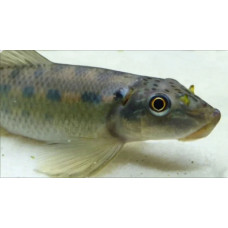Latin name
Gyrinocheilus aymonieri
Other name
Sucking loach, siamese algae-eater, Chinese algae eater.
Identification
The scientific name was given in honour of the French linguist and explorer Étienne Aymonier (1844-1929).
The honey sucker is the only species in the genus to have 9 branched dorsal rays and 36-40 lateral linear scales. The lower part of the mouth is equipped with a special "sucker" that allows the fish to attach itself to smooth surfaces. Antennas are absent.
Features of fish fins
There are no dark spots on the pelvic and anal fins of these fish.
Fish colouring
The colouration of the wild species varies from pale grey to olive, with darker markings along the lateral line, ranging from a continuous band with alternating upper and lower extensions to irregular dots. The underparts are usually lighter than the main colour. Some darker markings can also be seen along the back and on the caudal fin.
Distribution
Widespread throughout most of Southeast Asia. Found in the Chao Praya Basin, the northern Malay Peninsula, the Mekong Basin (Cambodia, Yunnan Province in China, Laos, Thailand and Vietnam), the Mae Klong Basin and the Se Bang Fai River.
Habitat
It is most often seen in large rivers, sometimes venturing into flooded fields.
Size
G. aymonieri has been recorded to reach at least 28 cm (11 inches) in length.
Behavior
The fish spends most of its time on flat surfaces such as rocks in flowing water, using its unusually shaped lower mouth to cling to rocks in stronger currents. Adults are territorial, with groups of 5 or more individuals.
Food and feeding habits
Primarily herbivorous, they feed mainly on algae, periphyton and phytoplankton, but will also eat insect larvae or zooplankton.
Reproduction
This species is difficult to breed in the home aquarium, although juveniles have been reported from overstocked tanks. There are currently no definite factors known to trigger spawning. Sex determination is difficult, although mature males may have breeding tubercles on their noses, while females become more plump. No information is available on the reproduction of honey suckers in the wild.
Fishing
The honey sucker is of interest to fishermen as a local food source and to the aquarium trade.
Relationship with a person
Harmless. Fish is sold as food in local markets and small fish are used for prahok.
Interesting facts
The honey sucker has a habit of using its mouth to suck up objects on the bottom. To keep the water flowing to the gills, this fish has two pairs of gill openings. When the mouth is closed, water enters through the upper holes and exits through the lower ones.
| Classification | |
| Phylum | Chordata |
| Class | Actinopterygii |
| Squad | Cypriniformes |
| Family | Gyrinocheilidae |
| Genus | Gyrinocheilus |
| Species | G. aymonieri |
| Features | |
| Conservation status | Least Concern |
| Habitat | Bottom |
| Life span, years | No information |
| Maximum body weight, kg | No information |
| Maximum length, cm | 28 |
| Sailing speed, m/s | No information |
| Threat to people | Edible |
| Way of eating | Planktonophage |
Honey sucker
Tags: honey sucker



